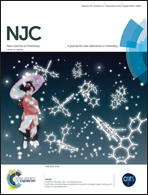Role of the cation formal charge in cation–π interaction. A survey involving the [2.2.2]paracyclophane host from relativistic DFT calculations
Abstract
The role of the metal formal charge in the cation–π interactions has been evaluated with relativistic DFT methods involving a versatile π-cryptating structure, namely [2.2.2]paracyclophane. Our study focuses on experimentally characterized [([2.2.2]pCp)M]n+ systems with M = Ag+ and Sn2+ and their Cd2+ and In+ counterparts, which exhibit 5s05p0 and 5s25p0 electron configurations. The acceptor capabilities increase when the metal charges go from 1+ to 2+, resulting in a large stabilization of the interaction. For the studied 5s05p0 cations Ag+ and Cd2+, the most stable conformation namely [(η2:η2:η2-[2.2.2]pCp)M]n+, the electrostatic contribution is more favorable by −9.3 kcal mol−1, whereas the ΔEOrb contribution increases by −151.6 kcal mol−1 towards a more favourable situation in the 2+ counterpart. Similarly in the 5s25p0 cationic group, the isoelectronic Sn2+ and In+ systems depict variation of the electrostatic and orbital terms, with a considerable decrease of the stabilizing ΔEOrb contribution, and in a lesser amount the ΔEElstat term. Thus, the variation of the interaction energy between the M+ and M2+ isoelectronic counterparts can be ascribed mainly to the variation of the ΔEOrb term, leading to a more covalent character of the interaction retaining a similar bonding scheme.
![Graphical abstract: Role of the cation formal charge in cation–π interaction. A survey involving the [2.2.2]paracyclophane host from relativistic DFT calculations](/en/Image/Get?imageInfo.ImageType=GA&imageInfo.ImageIdentifier.ManuscriptID=C5NJ02384J&imageInfo.ImageIdentifier.Year=2015)

 Please wait while we load your content...
Please wait while we load your content...